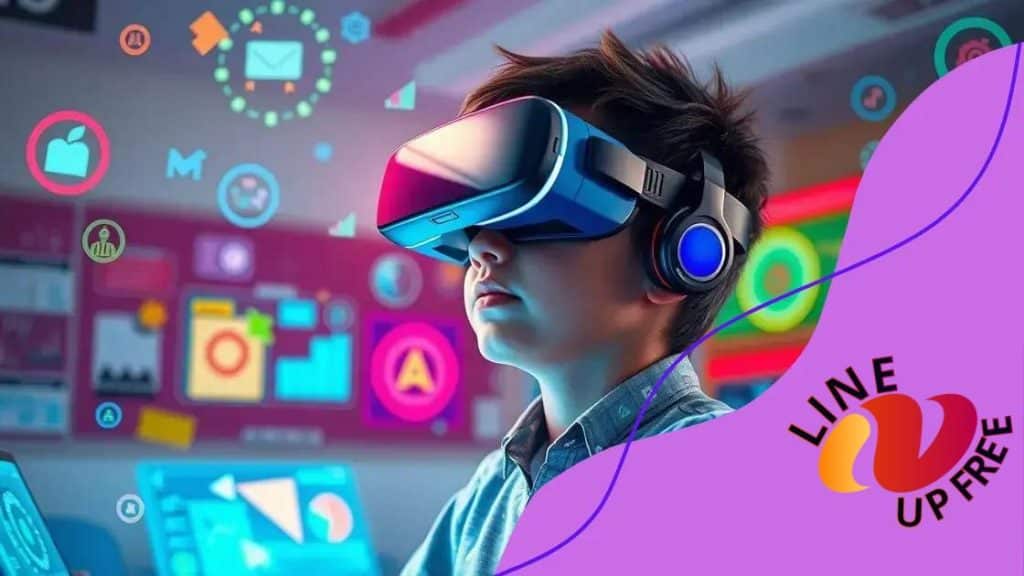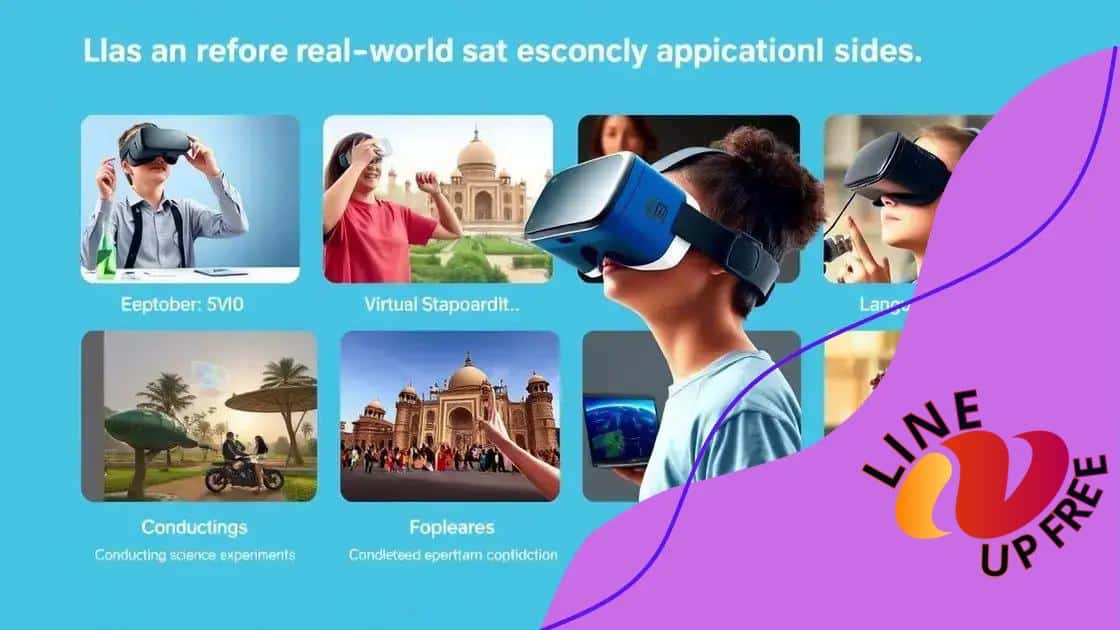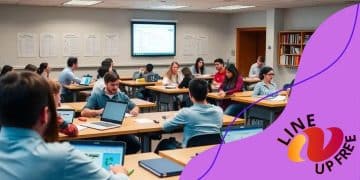The role of virtual reality in immersive learning experiences

Anúncios
The role of virtual reality in immersive learning experiences enhances student engagement and retention by providing personalized, interactive environments that simulate real-world scenarios in education.
The role of virtual reality in immersive learning experiences is transforming how we educate and engage students. Imagine stepping into a virtual world where learning feels alive, allowing learners to experience concepts firsthand. Intrigued by the possibilities?
Anúncios
Understanding virtual reality technology
Understanding virtual reality technology is essential to grasp how it enhances learning experiences. This technology immerses users in realistic environments, making education interactive and engaging.
Virtual reality (VR) transports learners into unique settings, allowing them to experience real-world scenarios. Through the use of headsets and motion tracking, learners can walk through simulations, interact with digital objects, and engage in collaborative tasks.
Key Components of Virtual Reality
Several key components make virtual reality powerful in educational settings:
Anúncios
- Immersive Environments: VR creates a sense of presence, making learners feel as though they are truly part of the experience.
- Interactive Elements: Users can manipulate and interact with their environments, deepening their understanding.
- Real-Time Feedback: Learners receive instant feedback, allowing them to improve their skills on the spot.
These features help engage learners, making concepts easier to understand and remember. For example, medical students can practice surgical techniques in a virtual operating room without any risk. They can repeat procedures until they feel confident and prepared.
In another instance, students studying history can take virtual field trips to ancient ruins, observing them from different angles and interacting with digital artifacts. This level of engagement transforms learning from passive to active, where students are participants rather than just observers.
Furthermore, the customization offered by virtual reality technology allows for tailored learning experiences depending on the learner’s needs. Instructors can create specific scenarios that align with their curriculum, making lessons more relevant and impactful.
The Future of VR in Education
The future of virtual reality technology in education looks promising. As technology advances, we can expect even more sophisticated simulations and broader applications across different disciplines. This growing accessibility may lead to improved educational outcomes overall.
Benefits of immersive learning
The benefits of immersive learning are increasingly recognized in educational environments. This approach leverages technology to create engaging experiences that enhance understanding and retention.
One of the greatest advantages is increased engagement. When students interact with content in immersive ways, they are more likely to pay attention and participate actively. For instance, a student in a virtual environment can explore a 3D model of the solar system, moving between planets and learning about their characteristics firsthand.
Enhanced Retention
Immersive learning also boosts retention rates significantly. Studies show that learners who use virtual reality tend to remember information better than those who learn through traditional methods. This is because the experience feels real and memorable. Active participation facilitates learning, making it easier to recall information later.
- Multisensory Experience: Immersive learning engages multiple senses, leading to deeper understanding.
- Safe Learning Environment: Students can practice skills without real-world consequences, which encourages exploration.
- Real-Life Applications: Learners can simulate practical scenarios, bridging the gap between theory and practice.
In addition, immersive learning offers opportunities for collaboration. Students can work together in virtual environments, discussing ideas and solving problems as a team. This collaborative aspect fosters communication skills, which are essential in today’s workplaces.
Another significant benefit is accessibility. Students from various backgrounds and abilities can experience learning on equal footing. VR can adapt to individual learning styles, helping break down barriers that traditional education may impose.
Increased Motivation
Lastly, immersive learning can lead to greater motivation among learners. By providing a fun, engaging, and interactive environment, students are eager to participate and explore new concepts. Think of it as a game that rewards curiosity and persistence.
Real-world applications in education

Real-world applications of virtual reality in education are reshaping traditional learning methods. By creating immersive environments, educators can bring lessons to life, making them more engaging and relevant.
One significant application is in science education. Students can explore complex topics like anatomy or chemistry through interactive simulations. For example, by using VR, learners can conduct virtual dissections or experiment with chemical reactions safely.
Field Trips and Historical Exploration
Another exciting use of VR is for virtual field trips. Instead of a traditional classroom lesson, students can visit historical landmarks, museums, or natural wonders from around the world. This type of immersive experience fosters a deeper understanding of different cultures and environments.
- Access to Remote Locations: Students can explore places they may never visit in real life.
- Engagement with History: Experiencing events as if they were happening in real time brings history to life.
- Enhanced Visual Learning: Seeing and interacting with historical settings aids memory retention.
Moreover, VR can be used in language learning. By simulating conversations in a foreign environment, students can practice speaking and listening skills. They can engage with native speakers and navigate real-life scenarios, which boosts their confidence and fluency.
The technology is also beneficial for training in vocational fields. For instance, medical students can practice surgeries in a risk-free virtual setting, gaining experience without any consequences to real patients. This hands-on practice helps in skill acquisition and prepares them for real-world challenges.
Special Education Benefits
In special education, VR can provide tailored experiences for students with different needs. For example, it can help students with autism practice social interactions through simulations. These controlled environments allow them to learn at their own pace and build confidence in social settings.
As VR technology continues to advance, its applications in education will likely expand. This evolution promises to create even more dynamic and effective learning environments that cater to diverse learning styles.
Challenges in implementing VR
Challenges in implementing virtual reality in education can impact how effectively it is adopted. While this technology offers exciting possibilities, schools and educators face several hurdles in its integration.
One major challenge is the cost associated with VR technology. Purchasing equipment like headsets and software can be expensive, making it difficult for some schools to afford. Additionally, ongoing maintenance and updates add to the financial burden. This can lead to unequal access, as wealthier institutions may benefit more than others.
Technical Issues
Another significant obstacle is the technical issues that may arise during implementation. Training staff to use VR effectively is crucial. Many teachers may not have the necessary skills to integrate it into their curriculum. Furthermore, schools may face compatibility issues with existing hardware and software.
- Limited Infrastructure: Not all schools have the infrastructure needed to support VR technology, like high-speed internet and sufficient electrical outlets.
- Software Availability: Quality educational content in VR is still developing. Teachers may struggle to find appropriate resources that align with learning objectives.
- Health Concerns: There are concerns about motion sickness and eye strain among students using VR headsets. Addressing these health issues is vital for encouraging use.
Additionally, educators must carefully consider the content delivered through VR. It is essential that the material is appropriate and effective, promoting meaningful learning experiences. If the content is subpar, it can detract from the educational goals.
Moreover, resistance to change is a common challenge. Some educators may be hesitant to adopt new technologies, preferring traditional teaching methods they are familiar with. This reluctance can slow down the integration process, preventing students from benefiting from immersive learning.
Long-Term Commitment
Finally, implementing VR requires a long-term commitment from educational institutions. This includes ongoing professional development for teachers, regular updates to technology, and curriculum adjustments to fully utilize VR’s potential. Without such commitment, the technology’s benefits may not be realized.
Future trends in virtual reality learning
The future trends in virtual reality learning promise to enhance educational experiences significantly. As technology continues to evolve, we can expect more innovative ways to engage learners and facilitate understanding.
One major trend is the increasing accessibility of VR technology. As prices for hardware decrease and more content becomes available, schools around the world will likely adopt VR tools. This widespread availability will help bridge gaps in educational opportunities, allowing more students to benefit.
Personalized Learning Experiences
Another trend is the move towards personalized learning. With VR, educators can tailor experiences to meet individual student needs. This means students can learn at their own pace and in a way that suits their unique learning styles. For instance, a student struggling with math can interact with virtual scenarios that specifically address their challenges.
- Adaptive Learning Technologies: These systems will adjust content and difficulty based on student performance.
- Collaborative Learning: VR will enable students to work together in virtual environments regardless of their physical locations.
- Gamification: Incorporating game-like elements into learning experiences will make learning fun and engaging.
In addition, VR is likely to integrate with other emerging technologies, such as artificial intelligence (AI) and augmented reality (AR). This convergence will create even richer learning experiences. AI can help analyze student data and suggest tailored VR content, while AR can overlay digital information onto the real world, enhancing the learning experience.
Moreover, as educational institutions recognize the benefits of experiential learning, we can expect a rise in the use of VR for practical training. Fields such as medicine, engineering, and environmental science will particularly benefit from realistic simulations, allowing students to gain hands-on experience without the risks associated with real-life practice.
Creative Content Development
Another exciting trend is the rise of user-generated content in VR. Educational content can be created by students and teachers, fostering creativity and engagement. Learning platforms may allow users to develop and share their VR experiences, making education more diverse and inclusive.
Finally, as the technology becomes more advanced, we may see immersive storytelling becoming a common method of teaching. This approach can captivate students’ imaginations and help them connect with learning material on a deeper level. By immersing students in narratives, education can become a transformative experience.
In summary, the use of virtual reality in education opens up exciting possibilities for engaging learners and enhancing their experiences. From real-world applications to future trends, the potential for immersive learning is vast. As technology becomes more accessible and integrated into classrooms, we will see personalized learning options expand, making education more relevant and effective. While there are challenges to overcome, the benefits of VR are undeniable. By embracing these innovations, educators can inspire a new generation of learners who are excited about their education and ready for the future.
FAQ – Frequently Asked Questions about Virtual Reality in Education
What are the benefits of using virtual reality in learning?
Virtual reality enhances engagement, boosts retention rates, and provides immersive experiences that make learning more effective and enjoyable.
What challenges do educators face when implementing VR?
Educators encounter challenges such as high costs, technical training requirements, and the need for appropriate content.
How can virtual reality personalize learning experiences?
VR allows for tailored experiences where students can learn at their own pace and focus on areas where they need improvement.
What future trends can we expect in virtual reality education?
Future trends include increased accessibility, integration with AI and AR, and a rise in user-generated content for diverse learning experiences.





